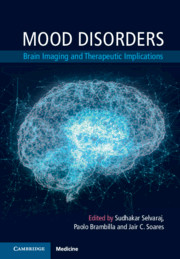Book contents
- Mood Disorders
- Mood Disorders
- Copyright page
- Contents
- Contributors
- Preface
- Section 1 General
- Section 2 Anatomical Studies
- Section 3 Functional and Neurochemical Brain Studies
- Section 4 Novel Approaches in Brain Imaging
- Section 5 Therapeutic Applications of Neuroimaging in Mood Disorders
- Chapter 17 Effects of Lithium on Brain Structure in Bipolar Disorder
- Chapter 18 Molecular Imaging of Dopamine and Antipsychotics in Bipolar Disorder
- Chapter 19 Brain Imaging and the Mechanisms of Antidepressant Action
- Chapter 20 Neuroimaging Studies of Effects of Psychotherapy in Depression
- Index
- Plate Section (PDF Only)
- References
Chapter 17 - Effects of Lithium on Brain Structure in Bipolar Disorder
from Section 5 - Therapeutic Applications of Neuroimaging in Mood Disorders
Published online by Cambridge University Press: 12 January 2021
- Mood Disorders
- Mood Disorders
- Copyright page
- Contents
- Contributors
- Preface
- Section 1 General
- Section 2 Anatomical Studies
- Section 3 Functional and Neurochemical Brain Studies
- Section 4 Novel Approaches in Brain Imaging
- Section 5 Therapeutic Applications of Neuroimaging in Mood Disorders
- Chapter 17 Effects of Lithium on Brain Structure in Bipolar Disorder
- Chapter 18 Molecular Imaging of Dopamine and Antipsychotics in Bipolar Disorder
- Chapter 19 Brain Imaging and the Mechanisms of Antidepressant Action
- Chapter 20 Neuroimaging Studies of Effects of Psychotherapy in Depression
- Index
- Plate Section (PDF Only)
- References
Summary
Bipolar disorder is an episodic, highly impairing mood disorder that is estimated to have a prevalence of 2–3% in the general population and is one of the leading causes of years lived with a disability.(1) Lithium is the gold standard for the treatment of bipolar disorder, and although it is a simple element, its effects on the brain are very complex.(2) Lithium’s potential neurotrophic and neuroprotective effects raise the intriguing possibility that it can potentially ameliorate abnormalities in brain structure and thus alter the disease trajectory.
- Type
- Chapter
- Information
- Mood DisordersBrain Imaging and Therapeutic Implications, pp. 219 - 235Publisher: Cambridge University PressPrint publication year: 2021
References
- 1
- Cited by

